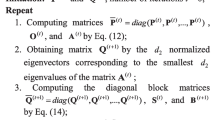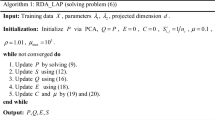Abstract
The latest linear least regression (LSR) methods improved the performance of image feature extraction effectively by relaxing strict zero-one labels as slack forms. However, these methods have the following three disadvantages: 1) LSR-based methods are sensitive to the noises and may lose effectiveness in feature extraction task; 2) they only focus on the global structures of data, but ignore locality which is important to improve the performance; 3) they suffer from small-class problem, which means the number of projections learned by methods is limited by the number of classes. To address these problems, we propose a novel method called Relaxed Local Preserving Regression (RLPR) for image feature extraction. By incorporating the relaxed label matrix and similarity graph-based regularization term, RLPR can not only explore the latent structure information of data, but also solve the small-class problem. In order to enhance the robustness to noises, we further proposed an extended version of RLPR based on l2, 1-norm, termed as ERLPR. The experimental results on image databases consistently show that the recognition rates of RLPR and ERLPR are superior to the compared methods and can achieve 98% in normal cases. Especially, even on the corrupted databases, the proposed methods can also achieve the classification accuracy of more than 58%.





Similar content being viewed by others
References
Bertsekas DP, Nedi A, Ozdaglar AE (2003) Convex analysis and optimization. Athena Scientific, Belmont
Cai D, He X, Han J, Member S (2006) Orthogonal laplacianfaces for face recognition. IEEE Trans Image Process 15(11):3608–3614
Cai D, Wang X, He X (2009) Probabilistic dyadic data analysis with local and global consistency. In: ICML
Campos T E, Babu B R,Varma M (2009) Character recognition innatural images. In: VISAPP
Cheng L, Yang M (2018) Graph regularized weighted low-rank representation for image clustering. In: CCC
Deng T, Liu J, Wang N (2016) Locally linear embedding preserving local neighborhood. In: ICNC-FSKD
Ebied RM (2012) Feature extraction using PCA and Kernel-PCA for face recognition. In: INFOS
Fang X, Xu Y, Li X, Lai Z, Wong WK, Fang B (2018) Regularized label relaxation linear regression. IEEE Trans Neural Netw Learn Syst 29(4):1006–1018
Georghiades AS, Member S, Belhumeur PN (2001) From few to many : illumination cone models for face recognition under variable lighting and pose. IEEE Trans Pattern Anal Mach Intell 23(6):643–660
Gui J, Sun Z, Hou G, Tan T (2014) An optimal set of code words and correntropy for rotated least squares regression. In: IJCB
Han L, Wu Z, Zeng K, Yang X (2018) Online multilinear principal component analysis. Neurocomputing 275:888–896
Han N, Wu J, Fang X, Wong WK, Xu Y, Yang J, Li X (2020) Double relaxed regression for image classification. IEEE Trans Circuits Syst Video Technol 30(2):307–319
He X, Niyogi P (2010) Locality preserving projections. Neural Inf Process Syst 16:153
He X, Yan S, Hu Y, Niyogi P, Zhang H (2005) Face recognition using laplacianfaces. IEEE Trans Pattern Anal Mach Intell 27(3):328–340
He X, Cai D, Yan S, Zhang HJ (2005) Neighborhood preserving embedding. In:ICCV
Huang G B, Mattar M, Berg T, Learned-miller E (2007) Labeled faces in the wild : a database for studying face recognition in unconstrained environments. Tech. Rep. 07-49, Univ. Massachusetts, Amherst.
Keyhanian S, Nasersharif B (2014) Laplacian eigenmaps modification using adaptive graph for pattern recognition. In: BIHTEL
Leng L, Zhang J, Chen G, Khan MK, Alghathbar K (2011) Two-directional two-dimensional random projection and its variations for face and palmprint recognition. In: ICCSA, pp 458–470
Leng L, Zhang S, Bi X, Khan M K (2012) Two-dimensional cancelable biometric scheme. In: ICWAPR
Li C, Shang M, Shao Y, Xu Y, Liu L, Wang Z (2019) Sparse L1-norm two dimensional linear discriminant analysis via the generalized elastic net regularization. Neurocomputing 337:80–96
Liang Z, Xia S, Zhou Y, Zhang L, Li Y (2013) Feature extraction based on Lp-norm generalized principal component analysis. Pattern Recogn Lett 34(9):1037–1045
Liu X, Yin J, Feng Z, Dong J, Wang L (2007) Orthogonal neighborhood preserving embedding for face recognition. In:ICIP
Liu G, Lin Z, Member S, Yan S, Member S (2013) Robust recovery of subspace structures by low-rank representation. IEEE Trans Pattern Anal Mach Intell 35(1):171–184
Liu JX, Gao YL, Zheng CH, Xu Y, Yu J (2016) Block-constraint robust principal component analysis and its application to integrated analysis of TCGA data. IEEE Trans Nano Biosci 15(6):510–516
Liu H, Lai Z, Chen Y (2017) Joint sparse locality preserving projections. In: SMARTCOMP
Lu GF, Zou J, Wang Y (2016) L1-norm-based principal component analysis with adaptive regularization. Pattern Recogn 55:207–214
Martinez AA, Benavente R (1998) The AR face database. Tech Rep Univ Autonoma Barcelona
Maximization L (2013) Linear discriminant analysis based on L1-norm maximization. IEEE Trans Image Process 22(8):3018–3027
Okfalisa, Gazalba I, Mustakim, Reza N G I (2017) Comparative analysis of k-nearest neighbor and modified k-nearest neighbor algorithm for data classification. In: ICITISEE
Pan H, Kang Z (2018) Robust graph learning for semi-supervised classification. In: IHMSC
Pan J, Zhang J (2011) Large margin based nonnegative matrix factorization and partial least squares regression for face recognition. Pattern Recogn Lett 32(14):1822–1835
Phillips PJ, Moon H, Rizvi SA, Rauss PJ (1997) The FERET evaluation methodology for face-recognition algorithms state university of new york at buffalo, amherst, NY 14260. pp 137–143
S Shao, Tang M (2019) Semi-supervised structured sparse graph data classification. In: AIAM
Sim T, Baker S, Bsat M (2003) The CMU pose, illumination, and expression database. IEEE Trans Pattern Anal Mach Intell 25(12):1615–1618
Torre FDL (2012) A least-squares framework for component analysis. IEEE Trans Pattern Anal Mach Intell 34(6):1041–1055
Wang N, Li Q, El-Latif AAA, Peng J, Niu X (2014) An enhanced thermal face recognition method based on multiscale complex fusion for Gabor coefficients. Multimed Tools Appl 72(3):2339–2358
Wang L, Zhang XY, Pan C (2016) MSDLSR: margin scalable discriminative least squares regression for multicategory classification. IEEE Trans Neural Netw Learn Syst 27(12):2711–2717
Wang H, Feng L, Yu L, Zhang J (2016) Multi-view sparsity preserving projection for dimension reduction. Neurocomputing 216:286–295
Wang L, Liu S, Pan C (2017) Rodlsr: robust discriminative least squares regression model for multi-category classification. In: ICASSP
Wen Y, Zhang K, Li Z, Qiao Y (2016) A discriminative feature learning approach for deep face recognition. In: ECCV
Wright YAY, Ganesh A, Sastry SS, Ma Y (2009) Robust face recognition via sparse representation. IEEE Trans Pattern Anal Mach Intell 31(2):210–227
Xiang S, Nie F, Meng G, Pan C, Zhang C (2012) Discriminative least squares regression for multiclass classification and feature selection. IEEE Trans Neural Netw Learn Syst 23(11):1738–1754
Xu J (2018) A weighted linear discriminant analysis framework for multi-label feature extraction. Neurocomputing 275:107–120
Yang J, Yin W, Zhang Y, Wang Y (2009) A fast algorithm for edge-preserving variational multichannel image restoration. SIAM J Comput 2(2):569–592
Ye Q, Yang J, Liu F, Zhao C, Ye N, Yin T (2016) L1-norm distance linear discriminant analysis based on an effective iterative algorithm. IEEE Trans Circuits Syst Video Technol 28(1):114–129
Yi S, Lai Z, He Z, Cheung Y, Liu Y (2017) Joint sparse principal component analysis. Pattern Recogn 61:524–536
Yin M, Gao J, Lin Z, Member S (2016) Laplacian regularized low-rank representation and its applications. IEEE Trans Pattern Anal Mach Intell 38(3):504–517
Zhang R, Nie F, Li X (2018) Feature selection under regularized orthogonal least square regression with optimal scaling. Neurocomputing 273:547–553
Zhao H, Wang Z, Nie F (2016) Orthogonal least squares regression for feature extraction. Neurocomputing 216:200–207
Zheng Y, Fang B, Yan Y, Zhang T, Liu R (2013) Learning orthogonal projections for Isomap. Neurocomputing 103:149–154
Zou H, Hastie T, Tibshirani R (2006) Sparse principal component analysis. J Comput Graph Stat 15(2):265–286
Acknowledgments
This work was supported in part by the Natural Science Foundation of China (Grant 61802267, Grant 61773328, Grant 61732011 and Grant 61703283), and in part by the Shenzhen Municipal Science and Technology Innovation Council under Grant JCYJ20180305124834854 and JCYJ20190813100801664.
Author information
Authors and Affiliations
Corresponding author
Ethics declarations
Conflict of interest
We declared that we have no financial and personal relationships with other people or organizations that can inappropriately influence on this work.
Additional information
Publisher’s note
Springer Nature remains neutral with regard to jurisdictional claims in published maps and institutional affiliations.
Rights and permissions
About this article
Cite this article
Bao, J., Lai, Z. & Li, X. Relaxed local preserving regression for image feature extraction. Multimed Tools Appl 80, 3729–3748 (2021). https://doi.org/10.1007/s11042-020-09802-9
Received:
Revised:
Accepted:
Published:
Issue Date:
DOI: https://doi.org/10.1007/s11042-020-09802-9




